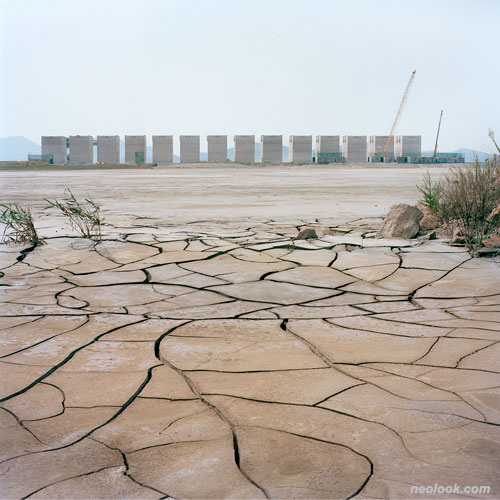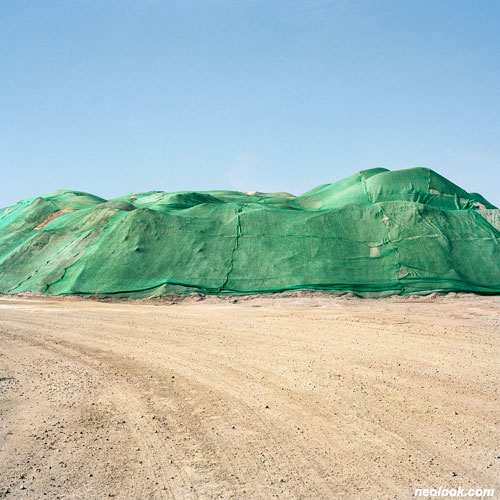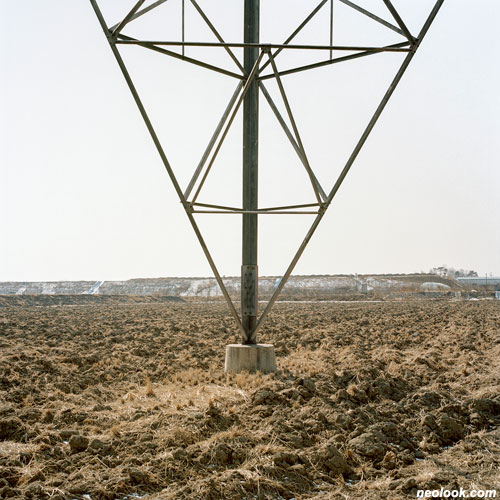- ● homepage
- ● archives
- ● restoration
- ● books
- ● big banners
- ● post board
- ■ neo's search
- ■ about us
- ■ 게재방법 안내
- 개인정보처리방침

- [email protected]
- Tel. 02_335_7922
- Fax. 02_335_7929
- 10:00am~04:30pm
- 월요일~금요일
- 3/3(월) 대체공휴일

가변적 풍경 Variable Geography
양지영展 / YANGJIYOUNG / 梁智英 / photography 2018_0310 ▶ 2018_0413
● 위 이미지를 클릭하면 네오룩 아카이브 Vol.20141023j | 양지영展으로 갑니다.
초대일시 / 2018_0310_토요일_06:00pm
관람시간 / 1100am~10:00pm
공간 이다 alternative culture space IDA 경기도 하남시 검단산로 271(창우동 249-7번지) Tel. +82.(0)31.796.0877 blog.naver.com/space-ida
가변적 지형 ● 끊어진 도로, 콘크리트 벽을 조용히 타고 내려오는 담쟁이 넝쿨, 평원에 널브러져 있는 거대한 산업부품들, 이러한 풍경들은 직선의 형태로 변화된 우리나라의 지형을 따라가다 보면 만나게 되는 풍경들이다. 복잡한 해안선은 간척지가 되어 곧은 형태의 지형을 만들어내고 그곳에는 수많은 산업시설물들이 자리하고 있다. 새롭게 형성된 넓은 땅은 거대한 산업단지를 형성하게 되었고 이곳을 둘러싼 주위는 거주하고 소비하는 또 다른 도시적 환경을 조성한다.

- 양지영_가변적 지형-갈라진 땅_피그먼트 프린트_100×100cm_2016
『가변적 지형』은 순천 남해안 프로젝트(2016)에 참여해 시작한 작업이자 도시 내부를 탐색한 기존 작업들을 확장한 작업이다. 우리나라의 지형의 변화를 지리적으로 물리적으로 쉽게 볼 수 있는 해안선과 그곳에 근접해 있는 지역들의 풍경을 바라보며 하나의 유기체로서의 지형의 속성을 살펴보고자 하였다. 한 도시가 생성해 발전하고 소멸해 가는 과정을 겪듯이 지형 또한 움직이는 유기체처럼 스스로 진화하기도 하고 타자의 힘에 의해 새로운 풍경으로 변모하기도 한다는 사실에 초점을 맞춰 이러한 경계 사이에 만들어지는 지형과 그 주변의 문화 환경을 기록하고자 하였다.

- 양지영_가변적 지형-녹색풍경_피그먼트 프린트_100×100cm_2018
바꿀 수 있거나 바뀔 수 있다는 가변적이란 사전적 의미에서도 알 수 있듯이, 우리가 살고 있는 땅의 모습은 끊임없이 변하며 그 안에서 일어나는 관계도 우리 스스로의 그 필요성에 의해 바뀐다. 풍경은 인간에 의해 수없이 재정비되고 있지만 자연 또한 그들의 방식으로 변화된 환경에 대한 적응의 방법을 모색한다. 풍경은 시대에 따라 그 의미와 해석이 달라지지만 결국 풍경은 축적된 시간 속에 만들어진 땅의 모습과 그곳을 이용하는 인간의 문화, 즉 행동 양식과 상징 체계를 보여주는 것이다. 풍경 이미지는 취사선택되고 구성된 하나의 텍스트로서 그것이 우리에게 어떻게 보이든지 간에 문화적 가계도를 반영하고 있다고 데보라 브라이트(Deborah Bright)는 말한다. 『가변적 지형』의 풍경들은 초월적 자연의 풍경도 아니고 기록을 목적으로 하는 풍경도 아니다. 『가변적 지형』의 풍경들은 인간이 만들어낸 공간에 대한 바라봄이다. 그리고 그 풍경의 실재를 찾아 떠난다. ■ 양지영

- 양지영_가변적 지형-F1 피라미드_피그먼트 프린트_100×100cm_2016
이미지와 메시지를 조율하는 방식 ● 복합문화공간 「공간 이다」에서는 2018년 3월 10일부터 4월 13일까지 양지영 초대전 『가변적 지형(Variable Geography)』을 개최한다. 이 전시는 10년 동안 독일 뮌스터예술대학의 필름 클래스에서 공부하고 Prof. 안드레아스 퀘프닉에게 마이스터슐러 학위를 사사받은 후 귀국한 양지영이 유학 중에 작업한 풍경 사진 『Abwesenheit(부재)』를 발표한 2011년 이후의 두 번째 개인전이다. 오랜 타국살이를 마치고 돌아온 양지영에게 의미 있게 다가온 사진적 대상은 진폭이 크고 속도가 빠른 한국의 변화된 풍경이었고, 그 풍경은 "개개 풍경의 표현은 시간을 좇아 땅에 반영된 인간의 가치와 행동을 기록한 것"이라는 데보라 브라이트(Deborah Bright)의 견해를 입증하듯 그가 타국으로 떠나 있었던 시간 동안 모국의 땅에 반영된 인간의 가치와 행동 양식이었다.

- 양지영_가변적 지형-무게와 시간_피그먼트 프린트_100×100cm_2016
그리하여 공간 조직 체계에 따른 한국 지형의 변화에 관심이 컸던 양지영은 이 『가변적 지형』에서 해안 지역의 풍경 작업을 시도하였다. 그것은 바다를 끼고 있는 해안 지역이 지형의 지리적 위상과 문화적 생태를 가장 잘 보여주는 공간이기 때문이었다. 연륙교 건설로 섬이 육지와 이어지고 다양한 산업 시설물들이 들어와 산업 기지를 형성하면서 끊임없이 파괴되어 개발되고 재정비되어 소비되고 있는 해안 지역은 산업자본주의 시대의 지형의 지리적 위상과 문화적 생태를 보여주기에 가장 적합한 소재였다.

- 양지영_가변적 지형-기름진 땅_피그먼트 프린트_70×70cm_2018
그러나 문화 현상에 대한 이러한 비판적 인식에도 불구하고 『가변적 지형』에서 문명비판적 어조를 파악하는 것은 쉬운 일이 아니다. 그것은 양지영이 우리의 삶터로서의 지형 역시 살아 숨 쉬는 유기체처럼 스스로 진화하기도 하고 외부적 요인에 의해 새로운 풍경으로 변모하기도 한다는 사실을 인지하고, 이러한 경계의 틈새에서 파생되는 지형과 그 주변의 문화 환경을 주시하고자 했기 때문이다. 즉 그가 작가 노트에서 밝힌 것처럼 "풍경은 인간에 의해 수없이 재정비되고 있지만 자연 또한 그들의 방식으로 변화된 환경에 대한 적응의 방법을 모색"하고 있기에, 그는 하나의 유기체로서의 지형이 자연과 어울려 생명을 유지해 가는 모습을 포착해 내었던 것이다.

- 양지영_가변적 지형-돌덩어리_피그먼트 프린트_100×100cm_2018
『가변적 지형』에서 문명비판적 어조를 파악하기 쉽지 않은 더 중요한 이유는 양지영이 이미지와 메시지를 조율하는 방식을 터득했기 때문으로 보인다. 그는 설명이나 진술보다 묘사나 상징에 더 적합한 6×6인치 핫셀블라드의 정방형 이미지를 사용하며 메시지를 지루하게 전달하는 것이 아니라 응축된 이미지를 보여주고자 하였다. 그 결과 변화하는 지형이나 정비되는 산업 시설물의 웅장한 규모가 아니라 그 인위적 구성물을 둘러싸고 있는 주변의 디테일한 흔적에 초점을 맞춘 일부의 이미지들은 더 상징적인 힘을 갖고 다가오게 된다. 파괴되고 건설되는 개발 과정이 아니라 인공의 흔적 속에 존재하는 자연의 자생력을 포착한 일부의 이미지들은 더 큰 묘사력을 획득하게 된다. 변화에 적응하기 위해 모색하는 자연의 방식을 포착한 그의 이미지들은 메시지보다 큰 울림으로 보는 이에게 더 많은 상상력을 부여하고 더 깊은 성찰을 유도하게 되는 것이다.

- 양지영_가변적 지형-넝쿨의 힘_피그먼트 프린트_100×100cm_2016
그렇다고 해서 메시지보다 이미지를 강조하는 이러한 방식을 양지영이 그의 모든 작업에서 일관되게 수용하고 있는 것은 아니다. 물론 탈구조주의 이론에 기대어 메시지의 부재를 염두에 둔 『Abwesenheit(부재)』는 이미지를 더욱 부각시킨 경우였다. 도시의 일상적 풍경 안에서 사람이 부재하는 텅 빈 공간을 정방형 프레임에 압축시킨 그 이미지들은 의미의 해체를 통해 새로운 의미가 생성되는 지점을 보여주고자 한 작업이었다. 그러나 양지영이 이미지보다 메시지를 강조하는 경우는 주로 우리나라의 사회문화적 현실에 근접하여 그 시대적, 역사적 의미를 파악하기 위해 카메라로 지역 탐구를 시도할 때이다. 일제 강점의 흔적이 남아 있는 군산 지역의 근대 서사와 경제 구조, 문화 양식과 공간 구조에 주목한 2000년 첫 개인전 『군산』의 다큐멘터리 작업이 그렇고, 그 후속 작업으로서 로컬리티(Locality)와 관련하여 장소 기억의 문제에 집중한 2010년 「군산 Ⅱ」의 풍경 작업이 그렇다. 군산 원도심 풍경에 내재한 생명력을 탐색한 2016년 「풍경의 숨」도 마찬가지이다. 그는 때론 직방형으로 때론 파노라마로 프레임을 달리하면서 자신이 선택한 세계에 따라 사진적 방법론을 탄력 있게 변용해 왔다. 특히 2016년 「여주 유랑길 프로젝트-여주두지」는 메시지가 꽤 비중 있게 다루어진 작업이었다. 그는 사진 전시와 함께 마을에서 채집한 물건들을 이용한 설치 작업을 병행하는 과정에서, 지역 주민들의 일상적 삶을 인류학의 조사 방법인 민족지(ethnography)적 '참여 관찰'을 통해 리서치한 후 그 결과물을 상당 분량의 텍스트로 기록하여 발표한 바 있다.

- 양지영_가변적 지형-도로의 벽_피그먼트 프린트_70×70cm_2016
이렇듯 독일의 예술대학에서 키운 형식과 매체를 자유롭게 넘나드는 글로벌한 시각을 바탕으로 전라북도 '군산', 경기도 '연천' '평택' '여주'와 전라남도 '순천' 지역을 거점으로 한 레지던시와 프로젝트에 참여하여 로컬리즘(Localism)에 접근함으로써 글로컬리즘(Glocalism)적 입장을 실천적으로 보여준 양지영은 이제 고고문화인류학과 박사과정 진학을 앞두고 있다. 인문학으로 다져진 양지영의 시각이 앞으로 펼쳐낼 사진 세계가 무엇일지, 그 세계가 어떠한 해석 체계를 거쳐 어떻게 의미화될지, 세계와의 상호작용을 위해 이미지와 메시지를 조율하는 표현 방식은 또 어떤 방향으로 전개될지가 궁금해지는 것은 사진예술과 문화학의 행복한 동거를 앞두고 열리는 양지영의 사진전이 이 봄날 아침을 더욱 설레게 하기 때문이다. ■ 김혜원

- 양지영_가변적 지형-송전탑_피그먼트 프린트_70×70cm_2018
Variable Geography ● Broken roads, ivy creeping down the concrete wall silently and huge industrial parts scattered in the plain; these landscapes are ones we come across, tracking Korean geography which has been transformed into a form of straight lines. Complicated coast lines have been turned into reclaimed lands and made a straight form of geography, and where lots of industrial facilities have been located. Huge industrial complex has been constructed in a newly formed broad land and its surrounding area provides citified environments to reside in and consume in. ● 『Variable Geography』 is a work started after participating in Suncheon South Coast Project(2016) and expanded my past works exploring inner city. It investigates properties of geography as an organism, looking at the coast lines and landscapes of its neighboring districts in which we can easily notice the change of geography geographically and physically. It is a record of geography and its surrounding cultural environments created between boundaries of changes, focusing on the fact that geography can also evolve of itself like a moving organism and be transformed into a new landscape by the power of the other just as a city goes through the process of creating, developing and disappearing. ● As you can see the definition of variable in the dictionary: 'able to change or to be changed', appearance of land we live in is being changed constantly and relationship built in it is also being changed by necessities of ourselves. As the landscapes are being refurbished by humans over and over again, nature is seeking for a way to adapt to the changed circumstances in their own ways too. Although the landscapes can have various meaning and interpretation according to the times, after all they show us the appearances of land which have been created over accumulated time and human cultures, that is, behavior patterns and symbolic systems, making use of the land. Deborah Bright said that the landscape image is a text selected and constructed and whether it is considered as whatever, the landscape image bears the imprint of its cultural pedigree. Landscapes in 『Variable Geography』 are not the ones of transcendental nature nor the ones with the intention of documenting. Landscapes in 『Variable Geography』 are to look at the places human has created. And now I hit the road to find the real of the landscapes. ■ Yang, Ji-young
A Method to Coordinate Images with Messages ● Alternative cultural space 「Space Ida」 holds Yang Ji-young Invitation Exhibition 『Variable Geography』 from March 10th till April 13rd, 2018. It is her second solo exhibition after she had an exhibition 『Abwesenheit』(2011) with her landscape photos she took while she studied film class at Kunstakademie Muenster for ten years and earned a Meisterschueler Brief by Prof. Andreas Koepnick in Germany. Korean landscapes of which change was wide-ranging and speedy, have become meaningful to Yang Ji-young, who had lived in a foreign country for a long time, as photographic objects, and those landscapes have been human values and behavior patterns applied on her mother land during the time she had stayed in a foreign country, just as it proves Deborah Bright's opinion that "every representation of landscape is a record of human values and actions imposed on the land over time.". ● Therefore Yang Ji-young who is much interested in the change of Korean geography according to the space organization system tries to take landscape photos of coastal area in 『Variable Geography』. It's because coastal area alongside the sea is a space to show us geographic status and cultural ecology of geography the best. Coastal area is one of the most proper subject matters showing geographic status and cultural ecology of geography in the times of industrial capitalism, since it is being constantly destroyed and exploited, refurbished and consumed, while bridge construction connects the island with the mainland and various industrial facilities are built in an industrial site. ● In spite of her critical perception of cultural phenomenon like that, it's not easy for us to catch her critical tones on civilization in 『Variable Geography』. It's because she realizes the fact that the geography as a base of our lives can also evolve of itself like an organism alive and breathing and transformed into a new landscape by external factors and tries to pay attention to the geography created between the boundaries of changes and its surrounding cultural environments. In other words she grasps the scenes that geography as an organism preserves its own life getting along with nature, as she says in her artist's statement that "As the landscapes are being refurbished by humans over and over again, nature is seeking for a way to adapt to the changed circumstances in their own ways too." ● It seems that more important reason it's not easy for us to catch her critical tones on civilization is because she has attained the method to coordinate images and messages. She tries not to transfer the message boringly but to show the condensed image, by using square image of 6×6 inches Hasselblad which is more suitable for descriptions and symbols than for explanations and statements. Consequently, some images, focusing on the detailed traces surrounding the artificial construct, rather than on grand scale of changed geography or refurbished industrial facilities, come up to us with more symbolic power. Some images, capturing self-regenerating ability of nature existing in artificial traces, rather than exploiting process destroyed and constructed, acquire bigger power of description. Her images in which she captures the method of nature to seek for to adapt to the change impose more imaginations on viewers and derive deeper introspections from viewers with bigger reflections than messages can do. ● Still, that doesn't mean that Yang Ji-young has consistently adopted in her all works this kind of method of putting more emphasis on image than message. Naturally 『Abwesenheit』 she keeps her mind on absence of messages in citing post-structuralism theory is one of the cases she puts more emphasis on images. The images she condenses into square frames empty places with absence of humans in daily landscape in a city are works in which she shows the point that deconstruction of meaning results in the creation of new meaning. However it is when Yang Ji-young tries to investigate local areas with her camera to figure out its historical significance of the times, approaching social and cultural realities in Korea that she puts emphasis on message more than image. It's also true in documentary photos of her first solo exhibition 『Gunsan』(2000) where she pays attention to modern narrative, economic structure, cultural style and space structure of Gunsan area in which traces of Japanese colonialism remain, and also true in 「Gunsan Ⅱ」(2010), her follow-up work, which she focuses on the problem of place memory concerning the locality. It's true again in 「Breath of Landscapes」(2016) she investigates vitality implied in the landscape in old downtown of Gunsan. She has selected various photographic methodology with flexibility according to the world she chooses, using various frames, sometimes square, sometimes panorama. Especially 「Yeoju Nomadic Road Project-Yeojuduji」(2016) is the work in which she highlights the messages more. She already presented in a good deal of text a record of research result of daily lives of the locals using ethnographic 'participant observation', one of research methods of anthropology, showing her installation using some objects she had collected from the local area at the same time as her photo exhibition. ● Like that so far she has shown us her "glocalism" perspective practically by approaching localism by participating in residencies and projects with bases of 'Gunsan', Jeollabuk-do, 'Yeoncheon' 'Pyeongtaek' 'Yeoju', Gyeonggi-do, 'Suncheon', Jeollanam-do, based on her global perspective of crossing over forms and media freely that she built up in a university of fine arts, Germany, and now she has doctor's course of archeology-anthropology ahead. It's because I am excited at her exhibition looking to happy cohabitation of photograph art and culturology this morning, one of spring day that I am anticipating what kind of photographic world will be revealed with her perspective with lots of knowledge of humanities, how the world will be signified by what kind of interpretation system and how her representation method to coordinate images with messages for interaction with world will be developed from now on. ■ Kim, Hye-won
Vol.20180311b | 양지영展 / YANGJIYOUNG / 梁智英 / photography

